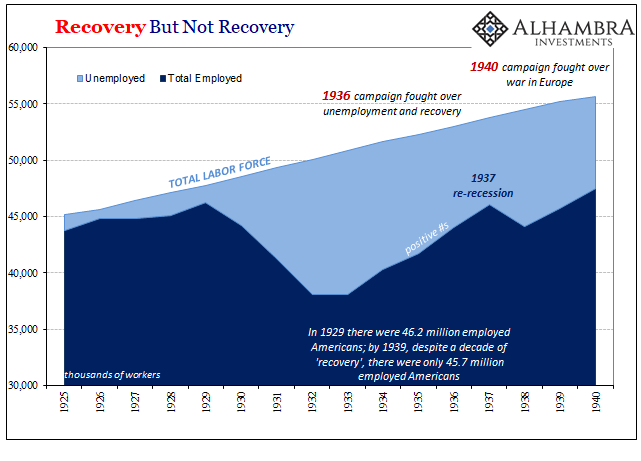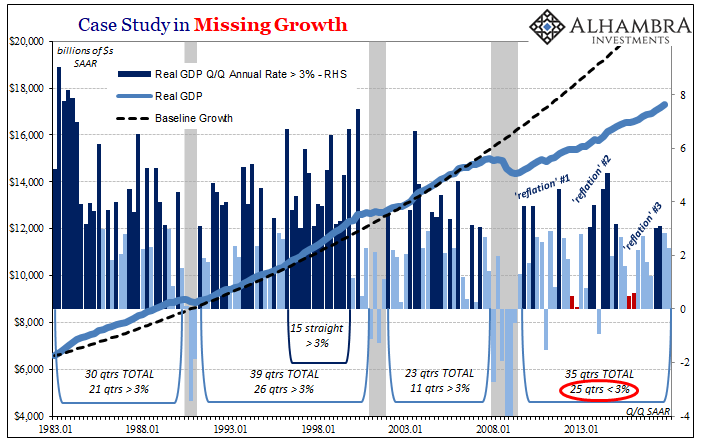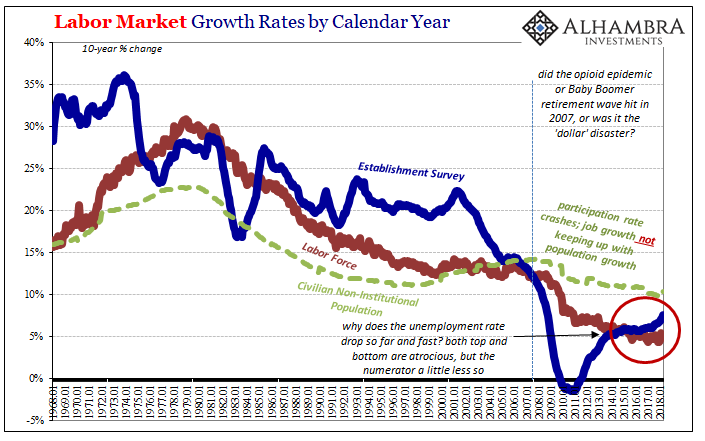The origins of the modern unemployment rate were, of course, political in nature. Before, the question was simple: you were either employed or you weren’t. There weren’t so many various stages of condition, a gradation that today is as enthusiastically applied to the very definition of the labor force itself.
In August 1937, Congress finally authorized a national survey of the unemployed. The Roosevelt administration had tried to obtain statutory approval several times before, but the matter was suddenly injected with some obvious urgency that overcame any ongoing objections.
It was to be carried out by the Post Office. This “voluntary registration” of the nation’s unemployed was meant to be exhaustive, but statisticians working in both the Works Progress Administration (WPA) and Census Bureau were concerned that any raw data could be tainted without additional effort. Therefore, along randomly selected postal routes the various carriers responsible for them would be conscripted as Enumerative Check Census takers.
The main survey was done by postcard asking a series of fourteen questions. The follow-up by interviewers was essentially re-interviewing people to validate responses more closely, to maintain and ensure confidence in the data (intending to obtain perhaps more truthful answers in a time when Americans weren’t as open to admitting to what in many people’s minds amounted to idleness).
The massive undertaking would take place starting Tuesday, November 16, 1937. The postcards were due back by midnight November 20.
Two days before the Postal Service sprang into action, the grand census was announced by President Roosevelt in one of his famous fireside chats over the radio.
This unemployment problem is, therefore, one in which every individual and every economic group has a direct interest. It is a problem whose discussion must be removed from the field of prejudice to the field of logic. We shall find the solution only when we have the facts, and having the facts, accept our mutual responsibilities.
But it was 1937 almost 1938. Unemployment should have become by then a backburner issue nothing much beside a residual concern applicable only to the most serious cases.
The recession of 1937 had begun several months before, which is why there appeared right then so much urgency to the task of defining unemployment. It was among the sharpest in the nation’s history, rivaling the Depression of 1920 in some measures, and it sprung up “unexpectedly” out of what had been before near uniformly characterized as “strong” and “robust” recovery.
Just six weeks prior to the postcards going out, in early October 1937 FDR was in Chicago having long before shifted his focus to global concerns quite intentionally away from domestic problems. He told his audience:
And yet, as I have seen with my own eyes, the prosperous farms, the thriving factories and the busy railroads, as I have seen the happiness and security and peace which covers our wide land, almost inevitably I have been compelled to contrast our peace with very different scenes being enacted in other parts of the world.
That wasn’t completely true, however, a fact further established by both the full 1937 unemployment census as well as its Enumerative Check. It had ended up finding 11 million unemployed and “emergency” workers, substantially more than existing estimates. According to prior methods, they had calculated about 7.7 million unemployed in 1937 toward the start of the recession and a max of 10.4 million in 1938 beyond its end. For a comprehensive, scientific survey coming at its middle, 11 million was a total shock.
It had been an election issue in 1936, too. The 1937 Census was in one part meant to judge once and for all those often bitter campaign debates that continued to linger. Republican Alf Landon, then the current Governor of Kansas, had accepted his party’s nomination to the top of the Presidential ticket on July 23, 1936. The theme of his candidacy was established very early on in his acceptance speech:
The world has tried to conquer this depression by different methods. None of them has been fully successful. Too frequently recovery has been hindered, if not defeated, by political considerations.
Our own country has tried one economic theory after another. The present Administration asked for, and received, extraordinary powers upon the assurance that these were to be temporary. Most of its proposals did not follow familiar paths to recovery. We knew they were being undertaken hastily and with little deliberation.
But because the measures were supposed to be temporary, because everybody hoped they would prove successful, and because the people wanted the Administration to have a fair trial, Congress and the country united in support of its efforts at the outset.
Roosevelt would respond throughout the election season with the same almost verbatim lines he would use in closing the campaign. At Madison Square Garden on October 31, 1936, just days before turning his case over to the voters, Roosevelt made his final pitch.
It is needless to repeat the details of the program which this Administration has been hammering out on the anvils of experience. No amount of misrepresentation or statistical contortion can conceal or blur or smear that record. Neither the attacks of unscrupulous enemies nor the exaggerations of over-zealous friends will serve to mislead the American people.
By 1938, however, the President was forced to concede those “unscrupulous enemies” were not, in fact, unscrupulous. They had been right all along.
On April 14, 1938, in another fireside radio chat, FDR spun hard but the harsh reality was clear enough anyway:
Today I pointed out to the Congress that the national income — not the Government’s income but the total of the income of all the individual citizens and families of the United States — every farmer, every worker, every banker, every professional man and every person who lived on income derived from investments — that national income had amounted, in the year 1929, to eighty-one billion dollars. By 1932 this had fallen to thirty-eight billion dollars. Gradually, and up to a few months ago, it had risen to a total, an annual total; of sixty-eight billion dollars — a pretty good come- back from the low point.
He chose to place his emphasis, as many in his position had before and continued to do long after, on the plus sign. From this view, the 90% increase off the bottom was evidence of good things, maybe even something like or even close to recovery (though that, too, was a little spin, as Roosevelt carefully constructs this comparison using early 1937-38 recession figures, in which he prefaces his numbers by noting they ran “up to a few months ago.”)

What Landon had said in 1936 and kept stressing each and every time until he handed off the nomination to Wendell Willke in 1940 was the other comparison. After ten years including almost six of presumed recovery, national income was still almost 20% less than the prior peak. It added up to something very different than recovery, instead the shock of 11 million still unemployed in November 1937 and an unemployment rate the census pegged at just over 20%.
Yet, Alf Landon was utterly destroyed in the 1936 election, falling in one of the most lopsided votes in American history. Roosevelt carried 46 of the 48 states, an Electoral College tally of 523 to Landon’s 8. The popular vote went 61% to FDR, and just 37% to the Republican.
The reason for this perhaps counterintuitive result was an idea the President would turn to throughout 1936. He used it again at Madison Square Garden to great effect in beginning the close of his final speech of the election:
For twelve years this Nation was afflicted with hear-nothing, see-nothing, do-nothing Government. The Nation looked to Government but the Government looked away. Nine mocking years with the golden calf and three long years of the scourge! Nine crazy years at the ticker and three long years in the breadlines! Nine mad years of mirage and three long years of despair! Powerful influences strive today to restore that kind of government with its doctrine that that Government is best which is most indifferent.
It resonated because the Great Crash was a paradigm shift. Paraphrasing, it may not be a real recovery but it isn’t 1932 and it’s not going to be. At least the numbers are now positive, even if they don’t amount to a return to full prosperity (as FDR was trying to say in 1938) or, as in the 1937 census, suggest just how far from that goal the US economy might remain. In other words, hey, it could be worse, the predecessor argument of jobs saved.
Landon’s primary fault was in how he never really stated the difference. It wasn’t enough to simply point out, “this isn’t recovery” nor was it enough to count on the bedrock American ideal that had been stacked against the kind of government interventions becoming normal in the thirties. Nobody wanted to go back, so it was incumbent upon his candidacy to both say why being against the New Deal wasn’t going back at the same time as offering a detailed explanation for what had just happened and how it could really be fixed by doing something different.
Beyond those, people at any point just want to believe that things are getting better. Even if the economy remains mired in mostly its same slump, so long as it isn’t getting worse there exists this tendency to accept the message all the same; to call it a recovery when it isn’t even close to one.
Fears of a renewed downside completely overwhelm increasingly distant memories of actual prosperity. It is Ben Franklin’s famous admonition transported to economic concerns. After great crashes, it is quite natural to want to trade maybe even the full upside away for some stronger sense of security. To hold tight and thoroughly embrace, maybe even celebrate, what’s happening now; to perhaps cheer the $68 billion even though you know full well it’s not $81 billion. Don’t rock the boat.
It is 2018 and banks aren’t failing like they were in what seems like a very long time ago. “We” know it isn’t recovery, but it’s not 2008, either. Maybe the economy isn’t really booming as so many now claim, but it’s not the worst case, either.
Except that it is; the boiling frog doesn’t notice the slight but steady rise in the water’s temperature. The 1940 election campaign ended up being fought along very different political lines. The primary issue wasn’t unemployment any longer, though the problem never was resolved. The President and Mr. Willkie would instead focus their entire debate on how this country might respond to even more extreme matters in Europe. The US wasn’t the only place where recovery had become acceptable in name only.





Stay In Touch